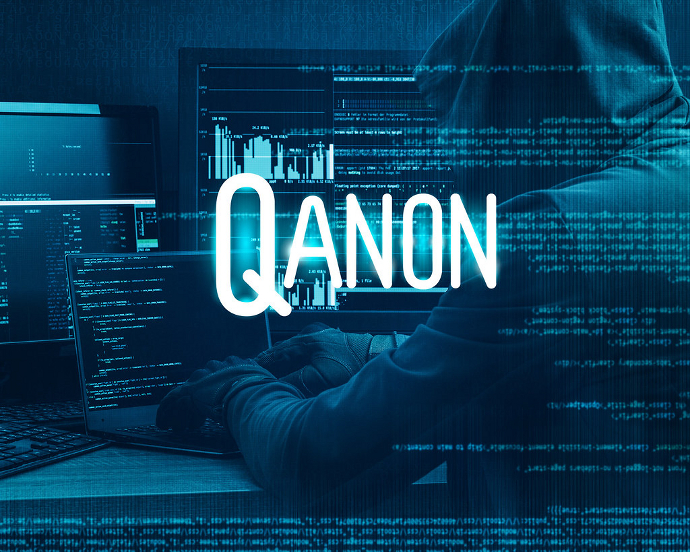The Deep State is coming to get your mama. Q said so — it MUST be true. Graphic by Mike MacKenzie.
The many faces of the radical right
and how to counter their threat
by Archie Henderson — Common Dreams
A whole ecosystem has grown up around the radical right as it has surged in visibility this century. The radical right can lay claim to its own stable of media personalities and political superstars, not to mention the social media platforms and political parties that cater to them. Its growth has been powered, in part, by some of the same social institutions that characterize and support mainstream culture: the political system itself, where many radical right parties attempt participation and in many countries field candidates; and the culture of social media, where followers can number in the millions. At times the radical right can rival mainstream actors in popularity and at times can even be indistinguishable from it.
As the radical right has captured media attention, it has likewise provoked heated opposition. Our report from the Center for Analysis of the Radical Right (CARR), entitled “Faces” of the Radical Right and now freely available shows just how far the radical right has expanded in reach and transnational influence in advancing political parties, organizations, and ideologues. The report makes use of photographs, graphs, and charts as it seeks to give order to what is by its nature a disordered subject.
The CARR report takes up both the racist, reformist radical right and the revolutionary, fascist extreme right while acknowledging that one shades into the other, and that some groups stand astride the very line that separates them. It shows that radical right groups are nativist and xenophobic and favor cultural and ethnic homogeneity. Their targets are those perceived to have contributed to national and political decline: corrupt or liberal elites, as well as Muslims and other immigrants or ethnic and religious minorities. Radical right parties typically compete in elections and seek to work within the existing constitutional structure of a country.
“To date, finding a universally satisfactory understanding of the term has proved elusive.”
While sharing the “sense of national decadence and a hostile attitude to minorities,” the extreme right parts company with the radical right in its opposition to constitutional democracy and in its endorsement of violence, which is inherent to revolutionary fascism’s efforts to overthrow the system and bring about an authoritarian state. By these measures, neo-Nazism is similarly classified as part of the extreme right, and has witnessed a resurgence over the last decade. Standing in the middle are groups like Britain First (BF), a UK radical right political party founded in 2011, which “operate on the cusp between radical and extreme right, tacitly endorsing violence without openly calling for it.”
So are all of these groups “radical right”? How is this term understood?
The second part of the CARR report addresses the questions, cataloging literally scores of definitions of the radical right that have been put forward since the 1950s. Yet to date, finding a universally satisfactory understanding of the term has proved elusive. Agreement has not yet coalesced around a single formulation (and is unlikely to); meanwhile, proposed definitions continue apace. In trying to find common ground, both historically and transnationally, our report suggests that “[t]he radical right, taken generally, is defined by its hostility towards those it perceives as weakening the nation state or ‘race’, notably immigrants, ethnic minorities, Muslims and Jews.” Indeed, this negative proposition—which seeks to define according to what the term being defined, the radical right, stands against, rather than what it stands for—holds true for a great many actors, groups, parties, and movements comprising the radical right. Even when a stated goal of the radical right seems positive, it is often the euphemizing of a negative goal. For example, Richard Spencer’s call for an ethno-state is, at bottom, a negative call for ethnic cleansing.
Our CARR report further contends that, today, “Muslims are often the main target of radical right attacks as a symbol of a growing ‘enemy within’ as either a direct threat to the nation or as seeking to dilute and degrade the nation’s traditional ethnic and cultural DNA.” This is borne out by evidence provided across the report. The catalogue of names included in our report also highlights that hostility toward Muslims—the default scapegoats of our time—can take the form of non-violent activity or outright violence. Islamophobia, however, is but one of a long list of radical right prejudices against minority ethnicities, and institutions. Opposition to one or more of those in the targeted list, as well as to the philosophies that support them, characterizes almost all factions comprises the radical right (as well as the extreme right).
Besides standing in opposition and open hostility to the “other,” what unites many of the otherwise disparate or even antagonistic elements within the radical right is conspiracism, where the alleged plotters are elites, Jews, or Muslims. Notable among these conspiracy theories is the “Great Replacement” theory, according to which the replacement of whites by Muslims in the West is being secretly carried out by elites. This is a view expressed by the counter-Jihad movement, Generation Identity, and more mainstream voices like Katie Hopkins. The closely-related “white genocide” conspiracy theory also finds supporters in Gavin McInnes, Stefan Molyneux, InfoWars, and Patrick Crusius.
The Alex Jones-led website InfoWars is a notable hotbed of conspiracy theories in this respect, promoting such fantasies as the theory that 9/11 was an “inside job”; that the Sandy Hook elementary school shooting in 2012 and the Pittsburgh synagogue attack were actually faked, “false flag” events; and that powerful Jews like George Soros are behind the national decline.
In the early 1960s, Jean-Paul Sartre saw the United States—“a nation of immigrants,” in John F. Kennedy’s words—taking its newcomers and molding them into conforming, and conformist, Americans, with a fellow countryman serving as a case in point. In a reversal of this “Ovidian metamorphosis” of alien elements into the American whole, some among the radical right see the process going in the opposite direction. Cultural and ethnic homogeneity—the status quo ante—is being slowly or not so slowly transformed beyond recognition into a Frankensteinian hybrid through race-mixing, or into an alien creature altogether.
For the American radical right this would entail an “Islamization of America,” a concept which lends its name to the group Stop the Islamization of America (USA). In the UK context, this means the alleged “Islamisation of Britain” (English Defence League); for France, it is the “Islamisation of French culture” (National Rally).
The success of the radical right has been built upon the backs of those it demonizes. Nonetheless, some of the targeted have fought back. Radical right demonstrations have engendered counter-protests. Doxxing and no-platforming have come to prominence as direct-action tactics in dismantling the far right. Our CARR report highlights four other techniques of private and governmental action that have been deployed to curb the radical right’s hateful speech and violent conduct These include social media bans, proscription by the UK government, barring entry of individuals into countries, and criminal prosecutions.
“The success of the radical right has been built upon the backs of those it demonizes. Nonetheless, some of the targeted have fought back.”
Subject to proscription by the UK government have been National Action (NA), NS131 (an offshoot of NA), and Scottish Dawn (another offshoot of NA). In February 2020 System Resistance Network (SRN) was deemed an offshoot of NA and added to the list of proscribed terrorist organizations, as was Sonnenkrieg Division (SKD), a splinter group of NA.
The most recent ban, which took effect in July 2020, is directed at Feuerkrieg Division (FKD), described by the Home Office as “a white supremacist group founded in late 2018 that has an international footprint, with members across North America and Europe. The group celebrates the concepts promoted in a collection of essays that advocate the use of violence and mass murder in pursuit of an apocalyptic race war.” Moving from group proscriptions to personal bans, the American fascist ideologue Richard Spencer has received an effective European ban, while the Austrian Generation Identity leader Martin Sellner is barred entry into the UK.
In a parallel move, on April 6 of this year, the US State Department designated the Russian Imperial Movement (RIM), a terrorist group that provides paramilitary-style training to neo-Nazis and white supremacists, as a “Specially Designated Global Terrorist,” or SDGT. As a consequence, their assets are blocked and US persons are generally prohibited from dealing with them.
These steps to counter the radical right may not be enough. As our CARR report concludes:
“The risks associated with increased radical right activism reach far and wide; street demonstrations continue to drain public resources, and the spike in mass-casualty ‘lone wolf’ terror attacks are indicative of a growing national security threat. Furthermore, the normalization of rhetoric from an increasingly emboldened radical right in the past decade risks poisoning public discourse, damaging community relations, and weakening liberal democracy itself.”
As its erasing of the cordon sanitaire and its move towards the mainstream have shown, it ought not be assumed that the radical right will collapse under the weight of its many internal conflicts and contradictions.
Archie Henderson is the head of research and bibliographer for the Center for Analysis of the Radical Right. He is a lawyer and independent scholar. His four-volume Conservatism, the Right Wing, and the Far Right: A Guide to Archives was published by ibidem Press in 2018.
Contact us by email at fund4thepanamanews@gmail.com
To fend off hackers, organized trolls and other online vandalism, our website comments feature is switched off. Instead, come to our Facebook page to join in the discussion.
These links are interactive — click on the boxes












